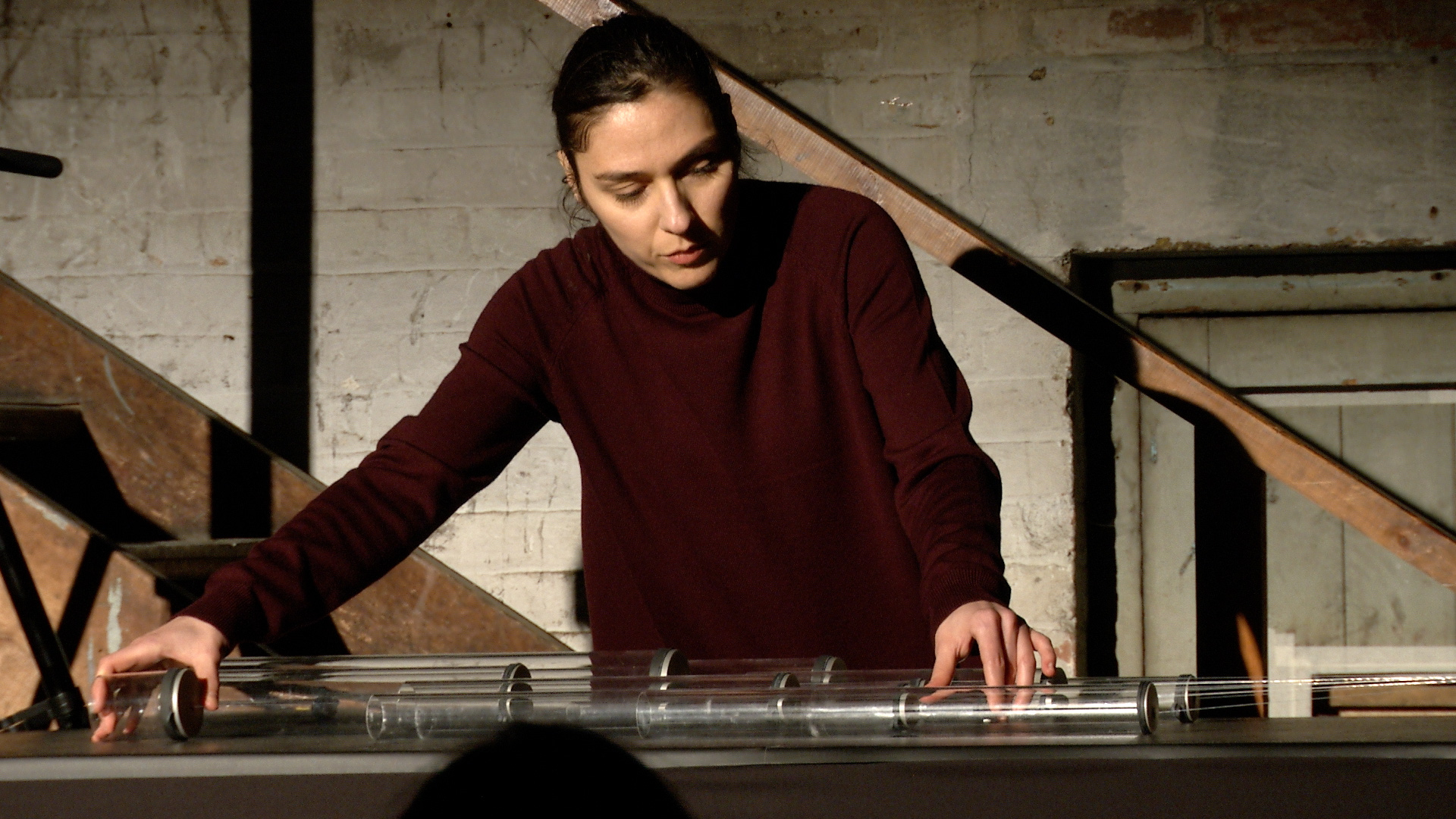Marianthi Papalexandri-Alexandri’s works are fascinating for seeing and hearing. Her pieces, which consists of a variety of objects, sound installations and performances, surprise visitors and listeners with the simplicity and elegance of their functioning. During my meeting with the artist, we discussed the intimate relationship between objects and sound.

Alexandre Babel
By entering the exhibition, a sound composition consisting of a multitude of short pulses fills the room. The sounds are so close together that one perceives a single, constantly moving structure. By approaching the object constituting Marianthi Papalexandri-Alexandris Modular n.3, the source of the sound moves closer to the visitors’ ear and he or her begins to distinguish the individual impulses from one another. The closer one gets to it, the more this installation object reveals its identity and sound. It is a continuous rotating movement that generates sound impulses through friction with a nylon thread, amplified by loudspeakers.
Marianthi Papalexandri-Alexandri, modular n.3, en collaboration avec Pe Lang, 2019.
The produced music, the third in a series of the same name created in close collaboration with artist Pe Lang, is therefore practically inseparable from its physical appearance. While the collection of loudspeakers creates a sound universe in its own right, understanding the production mechanism unfolds a narrative that reveals a concrete and poetic dimension. “I like to draw the audience’s attention to the way in which an instrument is built. In my opinion, the structure of my works is also based on the understanding of how they work”, explains Papalexandri-Alexandri.
Modular n.3’s principle is also reflected in other works by the artist, such as Untitled n.V or Speaking of Membranes and raises the question of the expectations associated with an object’s function. A loudspeaker is normally used to spread sound by amplifying electric energy. In this case, however, the loudspeakers are not connected, as the sound is acoustic.
“You recognise that it’s a loudspeaker, but I want to give it a privileged space, I want to hear its own voice.” If Papalexandri-Alexandri draws the audience’s attention to the essence of the object by making it vibrate through the movement device, what does it look like when the installation is not switched on or the object is exhibited as inanimate matter? The artist continues: “Sometimes I wonder what happens when a sound or musical object does not produce sound, is it a dead object? I think that every musical object is functional. When you set it in motion, you are exploring a certain kind of functionality. But maybe there are different functionalities to be explored on the same object.”
In Solo for generators, motors and wind resonators, a piece that was composed for recorder player Susanne Fröhlich, with whom Marianthi Papalexandri Alexandri has a long-term relationship, the connection to the instrument bypasses once again conventional expectations. A recorder, dismantled into its individual parts, is presented spread out on a table. On the same table a motorised device sets wires in rotation. These are connected to membranes stretched over the open parts of the recorder. The result is reminiscent of long waves of sound. “As we have dismantled the instrument, you can only see fragments of it”, explains the composer. Once more, the use of a musical object that is normally associated with a specific use, in this case the production of sound by blowing into the mouthpiece, is transformed into a sound manifestation produced by the instrument itself. Papalexandri-Alexandri continues: “When you place this instrument on a stage or as part of an installation, it becomes a resonant object. You see it as a body and no longer as a musical instrument that you recognise. This kind of process gives me the feeling of offering the audience a new approach to the instrument, a kind of tribute.”
Marianthi Papalexandri-Alexandri, salon de musique du 31, Susanne Fröhlich, Festival Archipel Genève, march 2019.
Marianthi Papalexandri-Alexandri’s world reveals an attention to manufacturing precision. The immaculate set-up of the equipment suggests that the artist seeks a certain control over the sequence of events. During the performance, however, the programmed control does give the work a rigid quality, on the contrary, it reveals a dimension of fragility emanating from the possible imperfections associated with the passage of time. In relation to the Solo for generators, motors and wind resonators, the composer tells us that control is never absolute. “When I play with this device myself, I can feel it and create beautiful sounds, and the same goes for Susanne (Fröhlich). But I’ve also experienced situations where the device did not work during the performance. This is due to the tension between the performer and the machine, which is necessary for the piece to take shape.”
This duality between control and fragility contributes to the poetic aura of Papalexandri-Alexandri’s works, as she explains: ‘Ultimately, it’s not really about control. My attitude is more about accepting events as they unfold.’ When asked how she would like to develop these events further, she replies: “What’s my personal contribution? I simply want to engage with the existing objects, they already have a lot to tell.”
Alexandre Babel
neo-profiles :
Marianthi Papalexandri-Alexandri, Pe Lang, Festival Archipel

